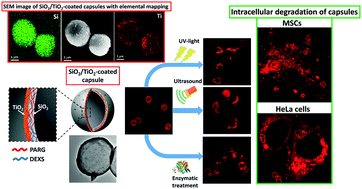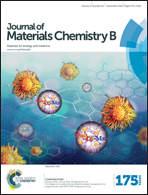Triple-responsive inorganic–organic hybrid microcapsules as a biocompatible smart platform for the delivery of small molecules†
Abstract
We designed novel hybrid inorganic/organic capsules with unique physicochemical features enabling multimodal triggering by physical (UV light, ultrasound) and chemical (enzymatic treatment) stimuli. Notably, the UV- and ultrasound response was achieved by a synergetic combination of TiO2 and SiO2 nanostructures which were in situ deposited into the polymer shell of microcapsules during sol–gel synthesis. This results in the formation of a composite hybrid shell with enhanced mechanical stability. Such sol–gel modification reduces the permeability of the capsule shell to allow for small molecule encapsulation. At the same time, these hybrid capsules consist of degradable polypeptides and polysaccharides and can be decomposed in response to enzymatic reaction. Upon employing different modes of treatment (UV-light, ultrasound or enzymatic degradation) we can stimulate different mechanisms of cargo release at desired times. Importantly, such capsules have been shown to be non-cytotoxic and can be internalized into human mesenchymal stem cells (MSCs) and cervical cancer cell lines (HeLa) revealing intracellular degradation. This work demonstrates that our hybrid capsules possess a triple stimuli-responsive effect, which is of capital importance for the future design and application of multimodal responsive platforms to improve externally stimulated release of bioactive compounds and their healthcare performance.



 Please wait while we load your content...
Please wait while we load your content...